Where did the Sakas live? What did they wear? How did they encounter Alexander the Great, and why did they have an affinity for fly agarics? These questions, among others about the ancient nomadic people, are answered by Kazakh historian and archaeologist, Alisher Akishev.
- 1. Pointed Hats and Fly Agarics
- 2. Military Affairs and the Appearance of the Sakas
- 3. What Language Did the Sakas Speak?
- 4. The Stronghold of the Sakas
- 5. How the Sakas Were Buried
- 6. The Society of Sakas
- 7. What Did the Ancient Sakas Believe In?
- 8. The Last Journey of the ‘Golden Man’
- 9. The Role of the Sakas in History
The term ‘Saka’ historically referred to numerous tribes living in the territories of present-day Kazakhstan (Zhetysu), Central Asia (Pamir, Fergana, and Khorezm), Eastern Turkestan, and Afghanistan between the eighth century BCE and the first centuries of our era. The name of the tribes may be derived from the Scythian word saka, meaning ‘deer’, but this is not certain. We don't know if it was a self-designation or a name given to them by neighboring peoples.
Although some Saka tribes were agriculturists and had notions of architecture and urbanism, the majority were engaged in horse and sheep breeding, and they predominantly led a nomadic lifestyle.
Pointed Hats and Fly Agarics
The Sakas were the successors of the Bronze Age culture known as the Andronovo culture1
Various ancient texts refer to the Saka differently. It is known that some of them settled in Media2

In Achaemenid inscriptions,4

Xerxes detail three types of Sakas//Wikimedia Commons
The first can be translated as ‘Saka in Pointed Hats’, but scholars' opinions diverge on the meaning of Sakā Haumavargā. In general, haoma is a plant that has a narcotic effect, which is much the same as Cannabis sativa or fly agaric. Some researchers claim that it refers to ‘Saka turning into wolves’ through the consumption of haoma. Others believe that ‘haumavargā’ means ‘preparing haoma’. Thus, the Sakā Haumavargā were well-known for their fondness for fly agaric and either indulged in the narcotic brew made from these mushrooms or, worse, turned into wolves after consuming it. Such occurrences, we must admit, are not uncommon even today. The most mundane of all turned out to be the representatives of the third group of the Sakas, the Sakā Paradrayā. They were simply the ‘Saka living beyond the river’. They were essentially identical to the Scythians, and ancient authors referred to the Sakas as Asian Scythians.
While enumerating various Saka tribes, Herodotus5

Foreigner hunting, circa 500 BCE/Gansu Museum/Wikimedia Commons
Ancient Chinese chronicles refer to the Sakas of Jetisu as ‘ses’ or ‘sai’ and recount their clashes with the Yuezhi people.6

Military Affairs and the Appearance of the Sakas
The Sakas were accomplished warriors, and their tribal organization provided an excellent foundation for their cavalry. The ‘civilized’ world knew them as magnificent horsemen, with their horses being renowned for their endurance. The Sakas had perfected many details of making horse harnesses. This is not surprising as horse breeding and horsemanship have been known in Kazakhstan since the Chalcolithic period. Sakas also had infantry warriors, mounted archers, as well as cataphracts—riders who fought in armor armed with spears and long swords. The latter category of warriors belonged to the Saka elite.
The military achievements of the Sakas were highly respected by their contemporaries. It is known that the Persian king Cyrus the Great (559–530 BCE) was killed in the battle with the Massagetae, and that he was killed by the Sakas in pointed hats. The army of Alexander the Great8

Edmund Ollier The Macedonians crossing the Jaxartes Publication date 1882/Wikimedia Commons
In written sources, however, the anthropological characteristics of the Sakas are almost absent. From The Anabasis of Alexander by Flavius Arrian,9
Thus, for instance, images of Sakas in pointed hats on reliefs on the staircase leading to the audience hall of the Persepolis Palace10
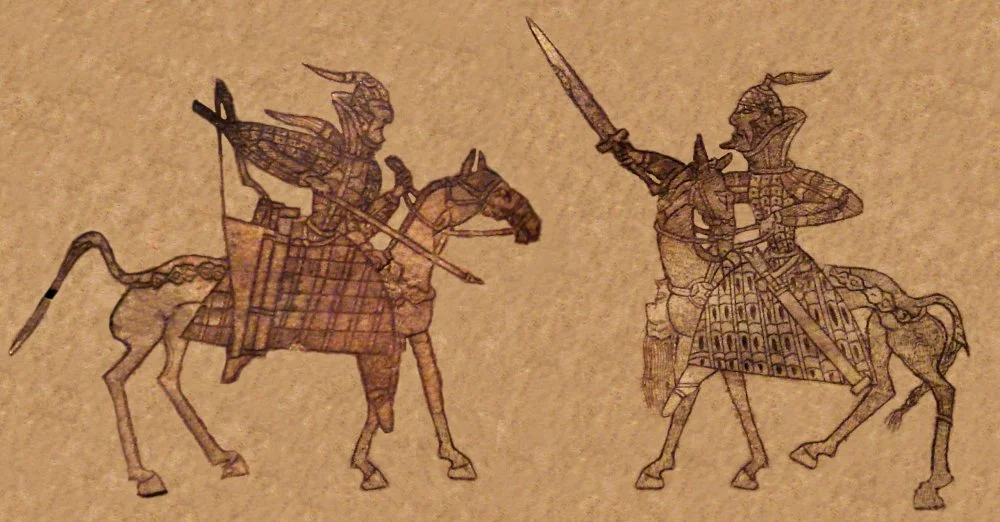
Battle scenes between "Kangju" Saka warriors, from the Orlat plaques. 1st century CE/Wikimedia Commons
The leader of the Sakas, whose remains were found in the Issyk Kurgan in Jetisu, was buried in similar attire adorned with ritual symbols. Despite belonging to the Europoid anthropological type, the deceased exhibited Mongoloid features, indicative of the intermingling of peoples from Central Asia. Most Saka skulls found in the Jetisu burial site share similar characteristics. The Sakas of the Pamir region predominantly had what is known as the Pamir-Fergana anthropological type. The Sakas-Haumavargā, those who enjoyed the brew of fly agaric, resembled present-day Afghans, and their attire resembled that of Bactria.11
What Language Did the Sakas Speak?
The Sakas belonged to the Indo-European language group. The names of the Sakas mentioned in written sources are primarily of north Iranian origin. The Khotanese-Saka language, known from the Buddhist texts found during excavations in eastern Turkestan, diverged from Iranian languages by the eighth century BCE. It is possible that some tribes, considered by their neighbors as Sakas, spoke Tocharian languages, which are non-Iranian and belong to the Indo-European languages of the centum group.
The linguistic affiliation of the Sakas, unfortunately, is not yet fully understood; however, some documents recently discovered during ongoing excavations provide some information. Thus, a silver bowl discovered in 1969–70 in the burial of a Saka king-priest in the Issyk burial ground contains an inscription written in an unknown language. It was later found that the inscription was either of an alphabetic or syllabic nature.12

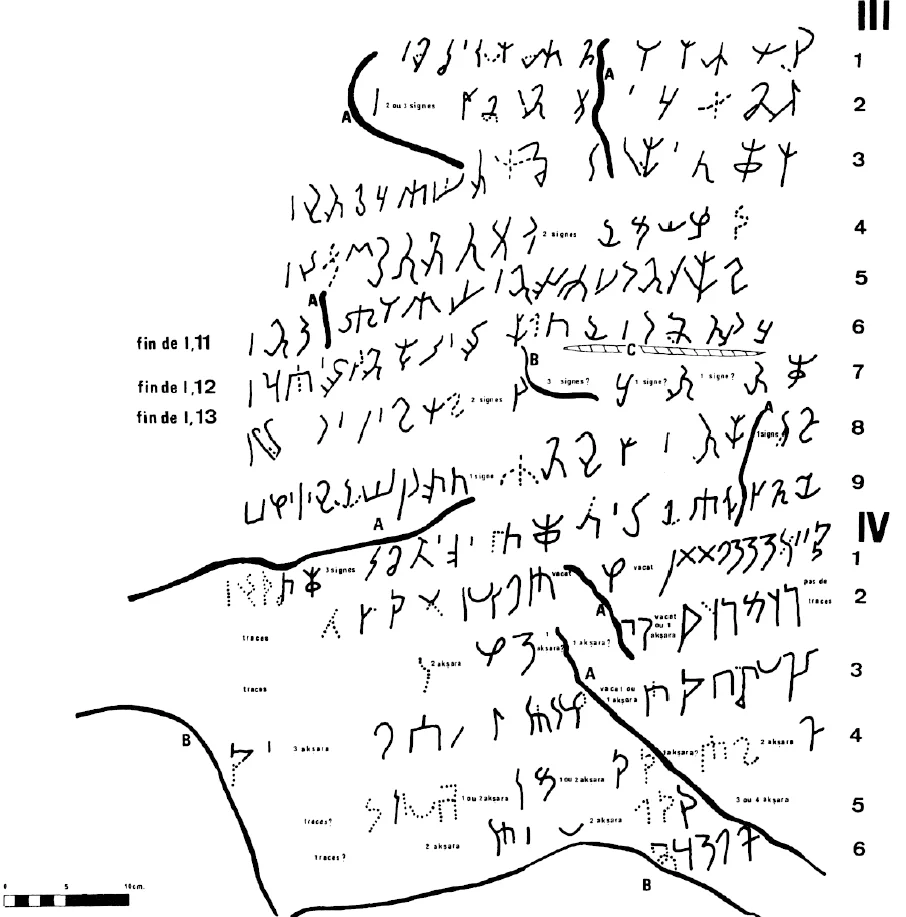
Trilingual inscription from Dasht-e Nawar. Afghanistan, 1st century AD. / Wikimedia commons
The author of this article, like V.A. Livshits, believes that the inscription here was made by the Sakas. The inscription from Dasht-e-Nawur is a trilingual one, meaning that the same text was represented in three languages. In the two deciphered texts, Greek-Bactrian and Kharosthi, there are mentions of campaigns by the Kushan king Vima Kadphises against the Saini people and his establishment of an altar to the god Mithra. The third inscription, in an unknown script, is the largest. As was later found, it contains text in one of the Saka languages spoken by the Great Yuezhi, the founders of the Kushan Empire. Thus, and this is an important achievement in understanding the history of Asia, the script of the Sakas was official in the empire of the Great Kushans.
The Stronghold of the Sakas
According to Iranian sources referring to the lands of the Sakas as Sakastan, the regions inhabited by these tribes covered the territory corresponding to southeastern Iran, Central Asia, and present-day Afghanistan. Indian sources refer to the area of the original settlement of the Sakas as the country of the Sakas—Sakadwipa.
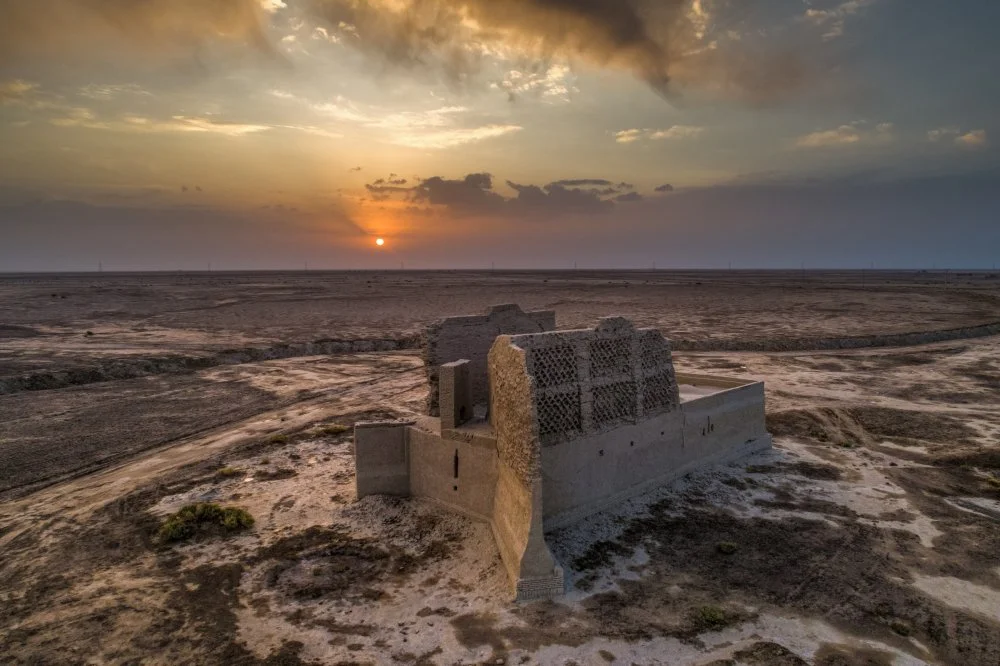
Asbad (windmills) in Sistan, Iran. 16th century / Wikimedia commons
So where exactly was this famous land of the Sakas, partially depopulated as a result of the Great Migrations?14

Buner reliefs Scythian bacchanalian cropped/Dan Diffendale/Wikimedia Commons
In any ancient society, the people are embodied by their leaders. The Sakas were no exception: the heart of the Saka country lay where their most famous ancestors were buried. Without a doubt, from the fifth to the first century BCE, the territory of Jetisu, like no other place, fit this definition. Indeed, nowhere else, whether in Central Asia, Kazakhstan, or Southern Siberia, have Saka burial sites of such impressive sizes been found. Some of them reach heights of 16 or 18 meters with diameters ranging from 100 to 150 meters. They are located in the foothills of the Tien Shan Mountains, in the valleys along the riverbanks. The burial mounds are grouped together and often form a complex of several dozen mounds.
How the Sakas Were Buried
The burial sites of tribal confederation leaders, tribal chiefs, and distinguished warriors were clearly distinct from other burial sites, and the difference in the size of the structures indicated the hierarchy that existed in the Saka elite. Archeologists have discovered places for sacrificial ceremonies, traces of fire and memorial feasts, underground passages and cromlechs,15
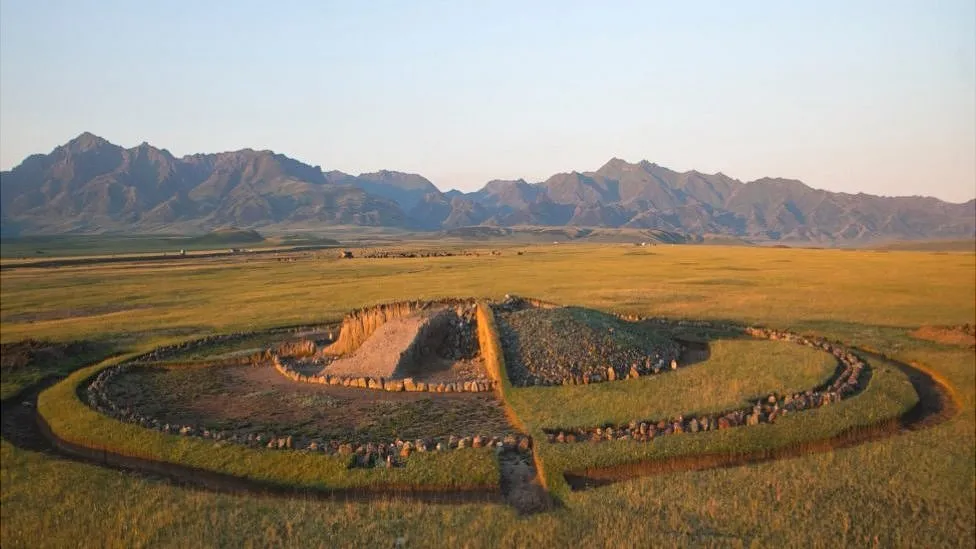
Excavated Saka burial mound, Kurgan 4, at Eleke Sazy/Yevgeniy Domashev
In some cases, remnants of temples associated with the cult of fire were recorded. It is evident that magnificent bronze and iron tripod cauldrons, altars, tables for sacrifices, censers for incense, cauldrons, and mortars and pestles used for rituals were placed there. All these items were crafted with great skill, and their decoration belongs to the ‘Scythian-Siberian animal style’. A significant number of workers were involved in the construction of royal tombs, which sometimes lasted quite a long time. For example, it was estimated that it would take a worker 4,000 days to build the Issyk burial mound, where a king (yabgu) who ruled the Sakas in the fourth and third centuries BCE was buried. The construction of the Bes-Shatyr burial mound in the Ili Valley by the same worker would have taken ten times longer.

Issyk kurgan © Заповедник-музей "Иссык"
The Sakas buried their leaders in wooden sarcophagi made of Tian Shan spruce or in stone tombs. Ordinary warriors with weapons were buried in stone cists16
The Society of Sakas
Saka society also included settled communities, whose residents were farmers or traders. The ornaments found in rich mounds were mostly made by these settled Sakas. Based on the sources we have, the warriors, from whom the future leaders were chosen, constituted the ruling class. In the Saka empires in India, there was a system of inheritance through the female line, similar to the practice in the kingdom of Elam.17
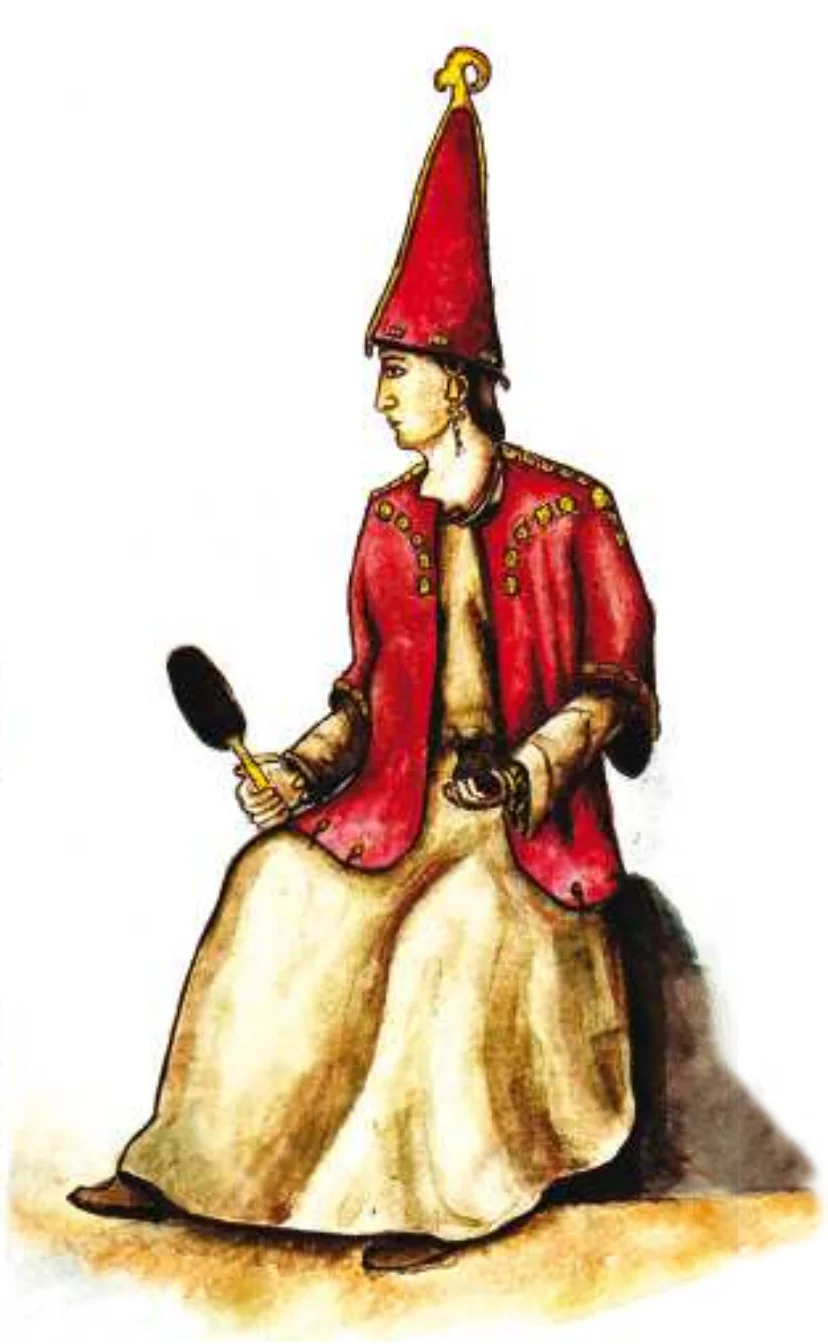
Reconstruction of Female Costume From the Elite Burial Ground Taksay-I: a View of the Archaeologist/Wikimedia Commons
Herodotus recounts that the Sakas, like many other Indo-Iranian peoples, used narcotics during their religious ceremonies. Thus, incense burners containing cannabis were discovered in the burial mounds of Pazyryk (Altai) and in the Issyk burial mound in Jetisu.
We know that the Sakas formed confederations of tribes led by a king. Thus, Saka society exhibited the structural characteristics of early class-based societies that emerged in the ancient world and in its features resembled Avestan society.18
What Did the Ancient Sakas Believe In?
The ideology of the Sakas was based on archaic Indo-Iranian myths, some of which have been preserved in the Rig Veda19


The sun god, like Mithra of the Avesta, likely held a central place in Saka mythology. The Saka king pledged allegiance to the sun, considering himself its representative and even the embodiment of Mithra on earth. As the personified center of the world, the unifier and father of all social classes, the leader was simultaneously considered the high priest. He would be buried by all his subordinates. Thus, the finest examples of Saka culture, symbols of all strata of society, are found in the royal tombs. Enemies of the Sakas knew about the hidden wealth in royal tombs. Many of the burial sites of Saka leaders were repeatedly looted during invasions of the Jetisu by the Yuezhi, Usun, Xiongnu, and other peoples. Some were also looted in the nineteenth century.
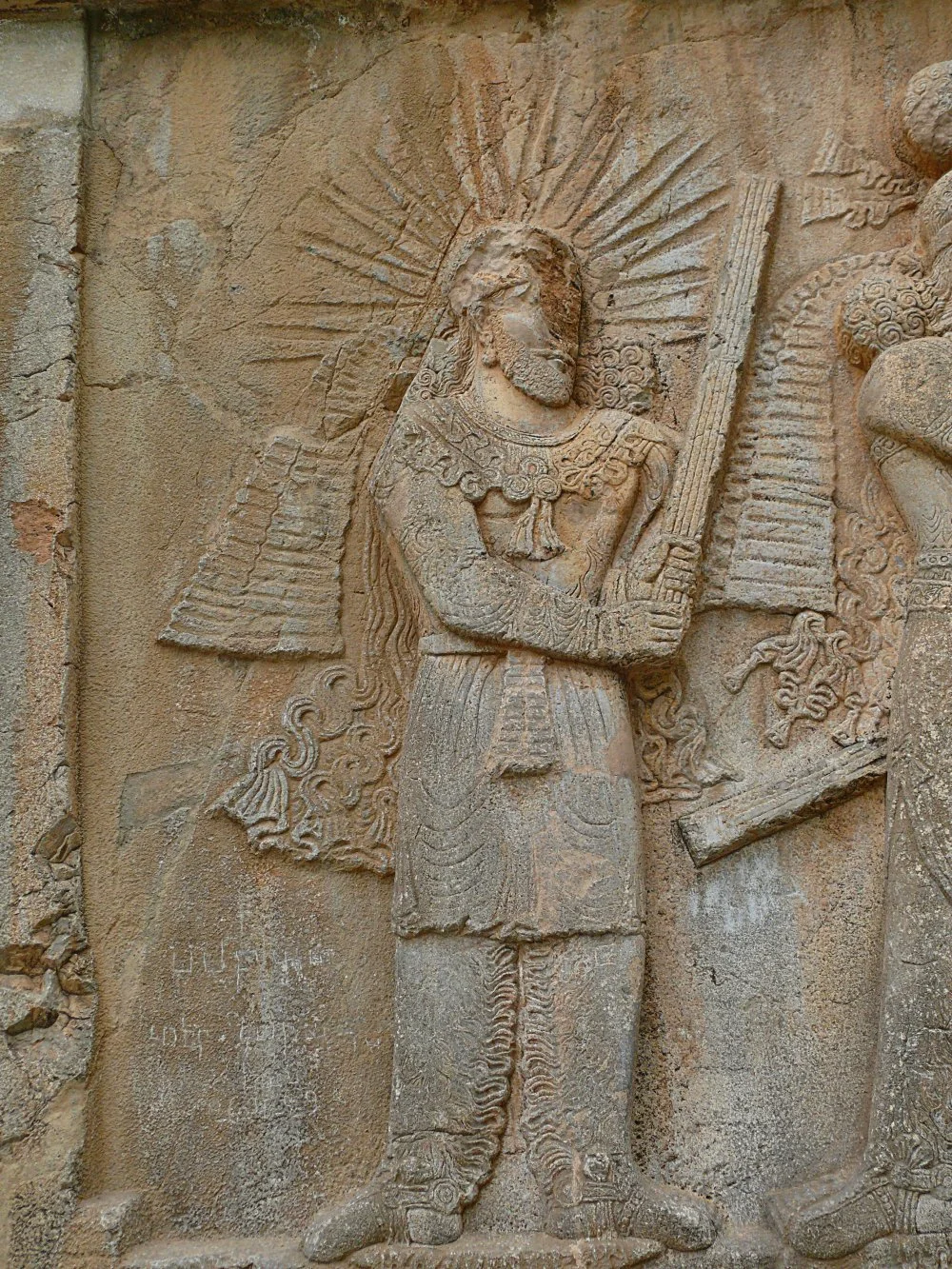
God Mithra on the rock relief of Shapour II at Taq-e Bustan (309-79 BCE) /Wikimedia Commons
The Issyk Kurgan, located in south-eastern Kazakhstan and excavated by archeologists from the Kazakhstan Academy of Sciences in 1969–1970, is an exception. The burial chamber found beneath the kurgan remained untouched by looters. It contained the remains of one of the leaders of the Saka confederation and was constructed at the turn of the fourth and third centuries BCE. Both in size and structure, this burial chamber, unlike the other royal kurgans in the burial ground, was nothing extraordinary.
The more lavish the ritual, the more convincing it was, and the Sakas, still at the height of their power, spared no expense in honoring their leaders. Many items found in the Issyk Kurgan were very valuable and, apparently, not used in everyday life. Others were only thinly coated with gold, revealing a familiar desire to impress.
The Last Journey of the ‘Golden Man’
Based on the position of the remains found beneath the Issyk Kurgan, it can be inferred that the body was laid on its back, with the head facing west in the left part of the burial chamber. To the right of the remains were items of a ritual nature: trays, dishes of various shapes and sizes, ladles, bowls, cups, and pitchers made of various materials (wood, ceramics, bronze). An engraved inscription was found on one of the bowls. Alongside the deceased, his sword and dagger were placed in scabbards inlaid with gold.
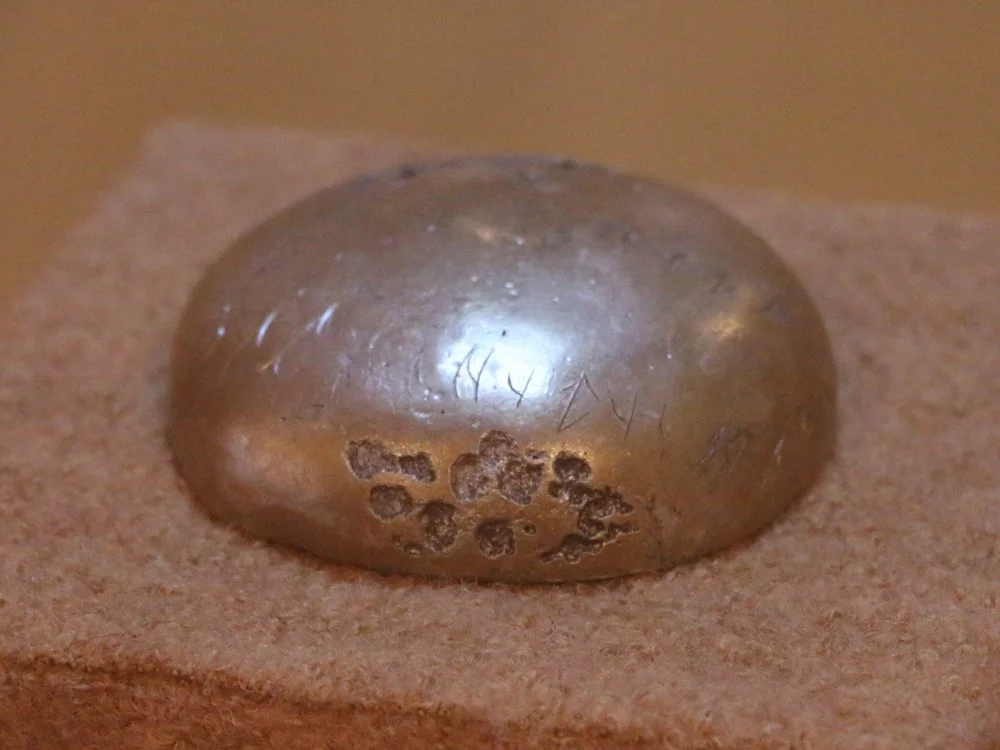
Issyk Dish. Yakov Fedorov//Wikimedia Commons
The end of the scabbard was tied to the leg of the deceased to prevent the weapon from hitting the leg while walking. In the left hand was a leather pouch adorned with gold and containing a mirror made of gilded bronze and cosmetic paint for rituals. He wore a gold torque necklace with images of tiger heads around his neck, representing symbols of power. On one of his gold rings was an image of the solar deity Mithra. The structure of the costume's decorative elements was associated with the Sakas’ conception of the ideal organization of the cosmos.
The deceased's ceremonial attire consisted of a leather jacket decorated with thousands of gold plates, narrow trousers, and tall boots. He wore a headgear consisting of a high, pointed cap with earflaps. This was the attire of a horseman. It is worth noting that Saka leaders were chosen from warrior-horsemen. The deceased’s jacket was possibly an imitation of a cataphract, the metallic defensive armor of a mounted warrior. The red and gold colors of the clothing symbolized, in the eyes of Indo-Iranian peoples, the warrior caste, which was associated with the sun. The protective value of this golden armor lay not in the strength of the gold but in its symbolic power, the magical strength of the solar metal.
The headgear, worn only during festivities and ritual ceremonies, was adorned with mysterious patterns arranged vertically and divided into three tiers. In the center was a decorative frieze with depictions of golden mountains and trees. At the foot of the mountains were earthly animals: tigers and goats, and on the mountain peaks were birds and winged tigers. The ornamentation, according to Saka beliefs, depicted the spine of the World Mountains surrounding the periphery of the universe. The decor also reflects the tripartite organization of the universe (from bottom to top): the underworld, earth, and the celestial realm. The animal figures arranged in the shape of a cross symbolize the four cardinal directions. At the center of the headgear composition was the emblem of the sun—four winged horses and four golden arrows. It also symbolized the cosmos as a whole and served as a royal insignia. Overall, the way the decorations on the headgear were composed epitomized dominion over the three spheres and the world illuminated by the sun as it moved from east to west.
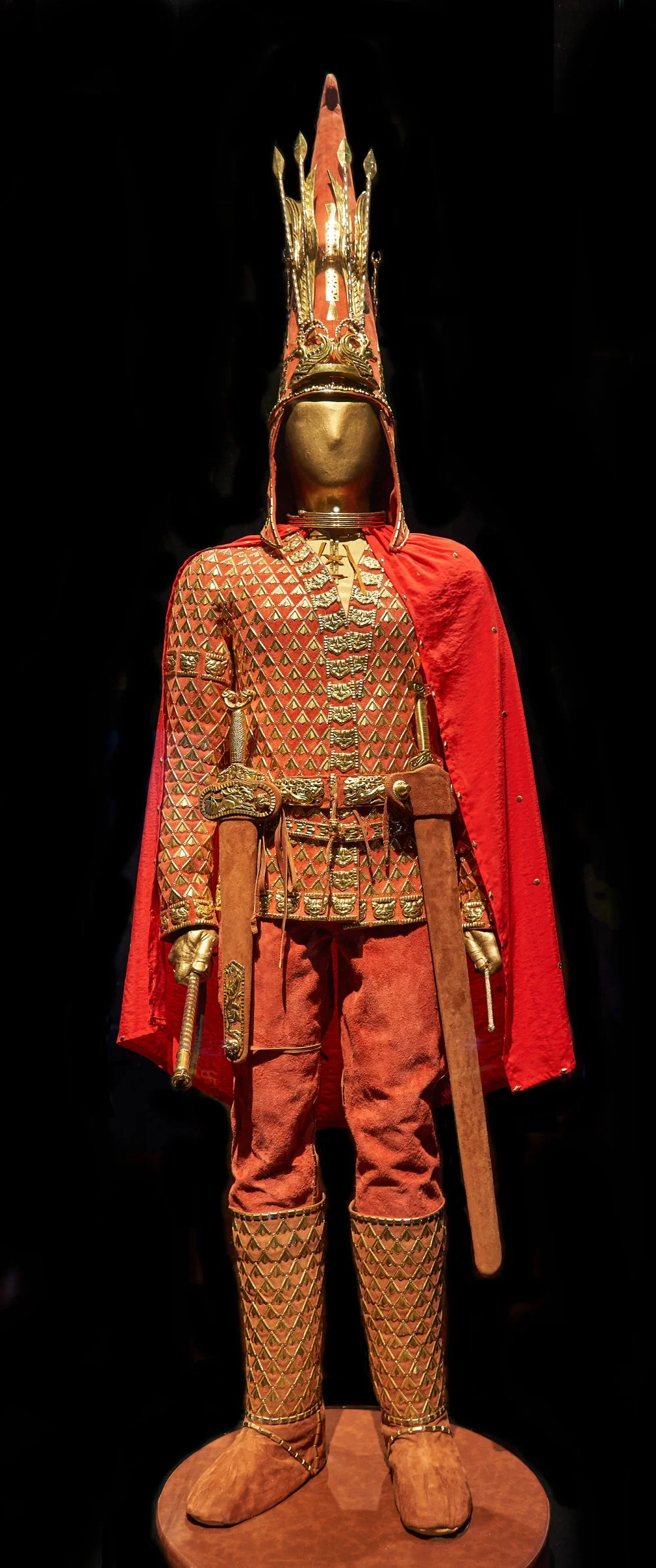
Issyk Golden Cataphract Warrior. A suit of armor consists of thousands of gold pieces / Wikimedia commons
Likely, during his lifetime, the Golden Man identified with the sun god and was considered the ruler of the world. Such notions of the scale of sacred authority among leaders were widespread among various ancient peoples. There is a significant similarity between the symbolism of the golden attire and Indo-Iranian Avesta mythology, and the hymns of the Rig Veda, and Zoroastrian cosmogonist texts compiled in the Pahlavi Bundahishn.22
Equally intriguing is the study of the zoomorphic decorations of that costume. On the one hand, they demonstrate close analogies with the art of the peoples of the Near East (Assyria, Babylon, Iran) and Bactria and the art of the south Siberian tribes and Central Asia (Pazyryk, Ordos art, and Hunnic art) on the other. The animal style as it existed among the Sakas of Jetisu represents original creativity. Saka art indicates the existence not only of military contacts but also of more productive creative connections with many cultures of the continent.
The Role of the Sakas in History
This animal style, combined with other elements, laid the groundwork for the emergence of the great art of the Kushans and Sogdians in the first centuries of our era. Additionally, the Huns and Sakas played a significant role in the development of the Han Chinese Empire.23
The era of the Sakas represents a pivotal moment in Asian history. At the beginning of the new era, the migrations of the ‘Saka circle’ changed the face of Eurasia.

Head of a Saka warrior, as a defeated enemy of the Yuezhi, from Khalchayan, northern Bactria, 1st century BC / Wikimedia commons
The study of this community and the significance of their legacy is just the beginning. It can be argued that the Sakas played a substantial role in the formation of peoples such as the Kazakhs, Kyrgyz, Uzbeks, Karakalpaks, Tajiks, and some peoples of Afghanistan (Dards), Iran, India, and China. Their name is possibly linked to the names used for the Yakuts (Sakha), Kazakhs (Sayaki), and Turkmens (Sakha).
The era of the Sakas coincided with two epochs in traditional European historiography: antiquity and the Hellenistic period. The contribution of the Sakas to the history of Asia can be compared to the influence that ancient culture and the achievements of Hellenistic city-states had on the nomadic peoples surrounding them.
